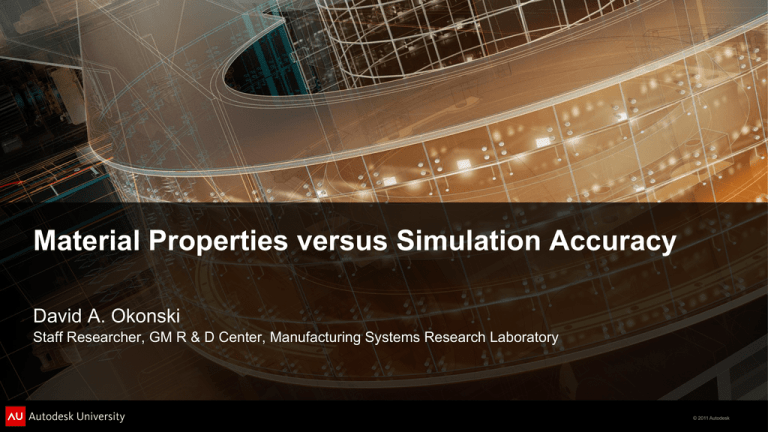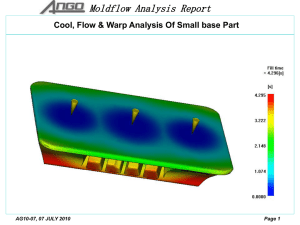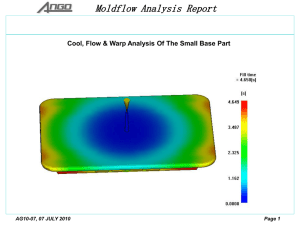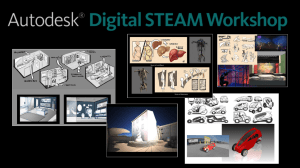
Material Properties versus Simulation Accuracy
David A. Okonski
Staff Researcher, GM R & D Center, Manufacturing Systems Research Laboratory
© 2011 Autodesk
Presentation Summary
The usefulness of thermoplastic injection-molding simulation is influenced by
many simulation inputs – such as the model of part geometry, mesh type and
density, process settings, and plastic material properties both as a melt and a
solid. This presentation will focus on the influence of the material properties data
file – the .udb input file – on simulation precision and accuracy.
© 2011 Autodesk
Presenter Background
GM employee for 28 years
Chemical Engineer turned into a Manufacturing / Plastics Engineer
Time spent in both Manufacturing Engineering and Research & Development
Currently Manager of the R&D Injection Molding Lab within the MSR Laboratory
Injection Molding Subject Matter Expert (SME)
Collaborate with Manufacturing, Materials, and Product Engineering on many projects
Primary work focus:
The precision injection molding of battery and fuel cell components
Alternative tooling strategies
Moldflow simulation validation studies
© 2011 Autodesk
R&D Injection Molding Lab
Husky Hylectric 120 (H120)
Husky Quadloc 1350 (Q1350)
Clamping Force = 120 metric tons
For thin wall stock, max part size:
Clamping Force = 1,350 metric tons
For thin wall stock, max part size:
TPO:
48 in2 (6 x 8 inches)
ABS / PC: 33 in2 (3 x 11 inches)
Nylon 66: 27 in2 (3 x 9 inches)
4-Axis Husky Tracer Robot
Interfaces: RJG (& MPX)
TPO:
545 in2 ( 9 x 60 inches)
ABS / PC: 375 in2 (15 x 25 inches)
Nylon 66: 300 in2 (12 x 25 inches)
6-Axis Fanuc Robot
Interfaces: Gas Inject, RJG, (& MPX)
© 2011 Autodesk
Why the interest in Material Characterization ?
Experience with simulation indicates that the material properties data file is the
leading source of error in all Moldflow analyses that are run for GM.
Quality of material properties data contained within the Moldflow database is suspect.
If Moldflow analysis is be used to the benefit of the Corporation, then the fidelity
of simulation results must improve.
Develop best practices for modeling and meshing part geometry on a commodity basis.
Improve the reliability of material properties data.
© 2011 Autodesk
Crucial Role for Moldflow Analysis within GM
For injection molded interior and exterior plastic components, GM’s Global
Vehicle Development Program (GVDP) allocates up to 12 weeks for adjusting
production tool steel – “mold tuning” – to produce a part to print specifications
prior to the first matching build event (M1).
M1 requirements – 80% of part dimensions to print – are not being met.
53% of all interior parts are not meeting M1 requirements.
28% of all exterior parts are not meeting M1 requirements.
© 2011 Autodesk
GM Moldflow Philosophy
M1 Requirements Scorecard must improve so as to impact the bottom-line of
the Corporation – Moldflow analysis is crucial to improving the M1 Scorecard.
GM Moldflow Mission Statement
GM Manufacturing Engineering – Global Paint & Polymers Center (GPPC) –
owns Moldflow analysis within the Corporation.
GPPC to use Moldflow Insight analysis as a virtual tool design aid to reduce the number
of tuning cycles to produce a part to print specifications.
GM intends to cut steel according to Moldflow Insight output – specifically, shrink and warp results.
Reduce the time to tool and improve the M1 Requirements Scorecard.
GM will develop in-house Moldflow expertise, develop in-house Moldflow best practices, and drive
Moldflow software improvements by working directly with Autodesk Moldflow and our consultants.
© 2011 Autodesk
Current Mold Construction and Mold Tuning Process
© 2011 Autodesk
Current Mold Construction and Mold Tuning Process
Moldflow analysis is not sourced until Tier 1 supplier is chosen.
© 2011 Autodesk
Desired State of Mold Construction and Mold Tuning
Virtual Mold Tuning Process
© 2011 Autodesk
GM Moldflow Strategy
Moldflow Analysis for Upfront Product Development and Design for
Manufacturability (DFM)
© 2011 Autodesk
GM Moldflow Strategy
Moldflow Analysis for Upfront Product Development and Design for
Manufacturability (DFM)
Reduce Process Variation through Standardization
GMW16355 – Global Moldflow Specification – defines how GM does a Moldflow analysis
for both an in-house analyst as well as a contracted external supplier of Moldflow
services.
Approved contracted suppliers of Moldflow services – Professional-level (Silver) Certification in 2011
and Expert-level (Gold) Certification in 2012.
Types of analyses for a given commodity – i.e.; fill + pack analysis sequence for fascia.
Acceptable mesh type (mid-plane, dual-domain or 3D) and mesh quality statistics for a given analysis.
Minimum report requirements for five (5) phases of Moldflow analysis.
© 2011 Autodesk
GM Moldflow Strategy
Approved Expert-level (Gold) Certified suppliers of Moldflow services to GM:
CAE Services / Beaumont Technologies / Bozilla Corp / FEAMold / Autodesk Korea
Five Phases of Moldflow Analysis:
Phase I:
Phase II:
Phase III:
Phase IV:
Phase V:
Establish number of gates and gate location(s).
Establish cold runner or hot manifold layout and design.
Establish cooling channel layout and design.
Establish optimum process for dimensional stability.
Reconciliation and validation of Moldflow results to first shots trial data.
© 2011 Autodesk
GMW16355 Moldflow Scorecard
© 2011 Autodesk
GM Moldflow Strategy
Moldflow Analysis for Upfront Product Development and Design for
Manufacturability (DFM)
Reduce Process Variation through Standardization
In-house Training of GM Manufacturing Engineers,
GPPC developing in-house expertise by requiring Manufacturing Engineers to be certified Moldflow
users.
100% of Manufacturing Engineers at Associate-level (Bronze) Certification in 2011.
50% of Manufacturing Engineers at Professional-level (Silver) Certification in 2012.
© 2011 Autodesk
GM Moldflow Strategy
Moldflow Analysis for Upfront Product Development and Design for
Manufacturability (DFM)
Require MPL-150 testing for all present and future GM production thermoplastic
materials.
Work to standardize Autodesk Moldflow Plastic Labs – all procedures; specifically, standardization of
the shrink test plaque between the Melbourne Lab and the Ithaca Lab.
GM characterizing 150 of our most used production materials over three years – 2011 through 2013.
Return-of-Investment (ROI) for MPL-150 testing for a single material is the elimination of just one mold “tuning”
loop.
© 2011 Autodesk
GM Moldflow Strategy
GM characterizing 150 of
our most used production
materials over three years
(2011 through 2013).
© 2011 Autodesk
GM Moldflow Strategy
Continuous improvement to answer the question: Is GM doing Moldflow
analyses correctly ? (Basic and Applied Research Activities)
Part Model
Is the correct mesh-type (mid-plane, dual-domain or 3D) being used for a given
commodity ?
Establish best practice for a given commodity.
How much detail needs to be included in the mesh ?
For instance, establish the number of layers that are required through the part thickness for a given commodity.
Expected Variation in Analysis Results
Will Expert-level certified users produce the same result given the same input data
(starting point) ?
Are certain Expert-level certified users better at analyzing a particular commodity than other Expertlevel users ?
© 2011 Autodesk
GM Moldflow Strategy
Continuous improvement to answer the question: Is GM doing Moldflow
analyses correctly ? (Basic and Applied Research Activities)
What is the sensitivity of analysis results on the material properties input file
(the .udb file), issues of concern are:
Use of a .udb file provided by the material supplier – the .udb file contains supplemental
material data from a 3rd party.
Use of a surrogate .udb file – the .udb file does not exist for the production material.
Use of .udb files for a global GM material that is compounded in different regions of the
World.
Use of a .udb file generated by Autodesk Moldflow Plastics Lab(s) that is older than two
years instead of using a .udb file generated by Autodesk Moldflow Plastics Lab(s) that is
based on a recent lot of material (effect of lot-to-lot variation).
© 2011 Autodesk
Material Properties versus Simulation Accuracy
Case Study # 1:
*Using a .udb file that contains supplemental data from the material supplier
versus a MPL-150 generated .udb file created at Autodesk Moldflow Plastics Lab.
*Use of .udb files for a global GM material that is compounded in different regions
of the World.
Material: LyondellBasell Hifax TRC779X (a semi-crystalline thermoplastic)
.udb file # 1 provided by LyondellBasell Industries (LBI) – mostly
party data from 2007
.udb file # 2 generated by Autodesk Moldflow Plastics (Ithaca) Lab in July of 2011 for the
North American version of 779X
.udb file # 3 generated by Autodesk Moldflow Plastics (Ithaca) Lab in September of 2011
for the Korean version of 779X
rd
3
© 2011 Autodesk
Material Properties versus Simulation Accuracy
Case Study # 1:
Simulating the fill time versus fill pressure curve for an end-gated, 3 x 10 inch
(76.2 x 254 mm) flat plaque injection molded using the Husky H120 IMM.
Experimental fill time versus fill pressure data was generated according to the principles
of Scientific Injection Molding at a melt temperature of 425ºF (218ºC).
© 2011 Autodesk
Material Properties versus Simulation Accuracy
Case Study # 1:
Fill + Pack analysis sequence run using a uniform and isothermal mold surface
temperature.
Other analysis sequences run:
Cool + Fill + Pack
Fill + Cool + Fill + Pack
Fill + Pack + Cool + Fill + Pack
Mesh-type (mid-plane, dual-domain or 3D) was chosen based on best-fit to the
experimental data.
© 2011 Autodesk
Case Study # 1: Fill Time vs. Fill Pressure Curve 3x10 Plaque
© 2011 Autodesk
Case Study # 1: Fill Time vs. Fill Pressure Curve 3x10 Plaque
Effect of mesh-type on simulation accuracy:
Best-Fit Mesh:
Dual-Domain with 36,963 elements.
Mesh Match Percentage = 99.8 %
Reciprocal Mesh Match Percentage = 99.6 %
© 2011 Autodesk
Case Study # 1: Fill Time vs. Fill Pressure Curve 3x10 Plaque
Effect of .udb file on simulation accuracy:
© 2011 Autodesk
Case Study # 1: Fill Time vs. Fill Pressure Curve 3x10 Plaque
Effect of .udb file on simulation accuracy:
© 2011 Autodesk
Case Study # 1: Fill Time vs. Fill Pressure Curve 3x10 Plaque
What are the differences in the material properties data:
© 2011 Autodesk
Case Study # 1: Fill Time vs. Fill Pressure Curve 3x10 Plaque
What are the differences in the material properties data:
Hifax TRC779X-NA_LBI_udb File
Hifax TRC779X-NA_MPL_udb File
Hifax TRC779X-KR_MPL_udb File
Hifax TRC779X-NA_LBI_udb File
Hifax TRC779X-NA_MPL_udb File
Hifax TRC779X-KR_MPL_udb File
© 2011 Autodesk
Case Study # 1: Fill Time vs. Fill Pressure Curve 3x10 Plaque
What are the differences in the material properties data:
Hifax TRC779X-NA_LBI_udb File
Hifax TRC779X-NA_MPL_udb File
Hifax TRC779X-KR_MPL_udb File
Hifax TRC779X-NA_LBI_udb File
Hifax TRC779X-NA_MPL_udb File
Hifax TRC779X-KR_MPL_udb File
© 2011 Autodesk
Material Properties versus Simulation Accuracy
Case Study # 2:
*Using a .udb file that contains supplemental data from the material supplier
versus a MPL-150 generated .udb file created at Autodesk Moldflow Plastics Lab.
*Use of .udb files for a global GM material that is compounded in different regions
of the World
Material: LyondellBasell Hifax TRC779X (a semi-crystalline thermoplastic)
rd
3
.udb file # 1 provided by LyondellBasell Industries (LBI) - mostly
party data from 2007
but CRIMS generated by Autodesk Moldflow Plastics Lab in October of 2011
.udb file # 2 generated by Autodesk Moldflow Plastics (Ithaca) Lab in July of 2011 for the
North American version of 779X
.udb file # 3 generated by Autodesk Moldflow Plastics (Ithaca) Lab in September of 2011
for the Korean version of 779X
© 2011 Autodesk
Material Properties versus Simulation Accuracy
Case Study # 2:
Simulating the warp of an end-gated, 3 x 10 inch (76.2 x 254 mm) ribbed plaque
that was filled at a melt temperature of 450ºF (232ºC) and at the minimum of the
fill time versus fill pressure curve.
Ram speed of Husky H120 IMM set to 0.4 inches/second (10.2 mm/second)
Fill + Cool + Fill + Pack + Warp analysis sequence run using a dual-domain
mesh.
Mesh contained 36,963 elements.
Mesh Match Percentage = 98.8 %
Reciprocal Mesh Match Percentage = 99.0 %
© 2011 Autodesk
Case Study # 2: Warp of 3x10 Ribbed Plaque
© 2011 Autodesk
Case Study # 2: Warp of 3x10 Ribbed Plaque
Warp in z-direction measured by establishing an xy anchor plane:
© 2011 Autodesk
Material Properties versus Simulation Accuracy
Case Study # 3:
* For a given GM material specification, using a surrogate .udb file for a “like”
material because the MPL-150 generated .udb file for the actual production
material is not available.
Material Files:
Surrogate Material: Samsung SI43G (semi-crystalline thermoplastic)
.udb file generated by Autodesk Moldflow Plastics Lab in November of 2009.
Mechanical properties data is supplemental.
Production Material: LyondellBasell Hostacom HKG743T (semi-crystalline thermoplastic)
.udb file generated by Autodesk Moldflow Plastics (Ithaca) Lab in April of 2011.
© 2011 Autodesk
Material Properties versus Simulation Accuracy
Case Study # 3:
Simulating the warp of the Alpha Console Structure.
Cool + Fill + Pack + Warp analysis sequence run using:
A melt temperature of 450ºF (232ºC).
A uniform mold surface temperature of 120ºF (49ºC).
A fill time of 2.5 seconds.
A mid-plane mesh was used having 40,181 elements.
Small deflection warp analysis run.
© 2011 Autodesk
Case Study # 3: Warp of Alpha Console Structure
© 2011 Autodesk
Case Study # 3: Warp of Alpha Console Structure
© 2011 Autodesk
Case Study # 3: Measuring Warp of L & R Channel Width
Left (L) Channel
Right (R) Channel
© 2011 Autodesk
Case Study # 3: Measuring Warp of L & R Channel Width
Effect of .udb file on warp of left and right channel width:
© 2011 Autodesk
Concluding Comments
The usefulness and applicability of results from Autodesk Moldflow 2012
depends on the “goodness” of the material properties contained within the .udb
file.
The analyst must have a high degree of confidence in the lab – the Autodesk
Moldflow Plastics Lab – generating the material properties data file for the
purpose of simulating the thermoplastic injection-molding process.
© 2011 Autodesk
Concluding Comments
Based on the data presented here and past experience within GM, it is our
belief that:
The use of a .udb file provided by a material supplier containing 3rd party supplemental
material properties data is not acceptable.
The use of a surrogate .udb file in place of that for the production-intent material is not
acceptable.
The use of an Autodesk Moldflow Plastics Lab generated .udb file older than 2 to 3 years
is not acceptable.
GM will strive to maintain an up-to-date and confidential material properties data
base of our most heavily used thermoplastic materials – no MPL-150 generated
material file shall have a lifespan of more than 2 to 3 years.
© 2011 Autodesk
Presentation Additional Material – Simulation Accuracy
Sensitivity of Autodesk Moldflow 2012 Insight results on quality of .udb file.
Using a .udb file that contains supplemental data from the material supplier versus a
MPL-150 generated .udb file created at Autodesk Moldflow Plastics Lab.
Simulating the fill time versus fill pressure curve for an end-gated, 3 x 10 inch (76.2 x 254
mm) flat plaque; experimental fill time versus fill pressure data was generated according
to the principles of Scientific Injection Molding. Fill + Pack analysis sequence run using a
uniform and isothermal mold surface temperature. Mesh type (mid-plane, dual-domain or
3D) was chosen based on best fit to experimental data.
Material: SABIC Cycolac BDT6500 (an amorphous thermoplastic)
.udb file # 1 provided by SABIC Innovative Plastics US, LLC
.udb file # 2 generated by Autodesk Moldflow Plastics (Ithaca) Lab in November of 2011
© 2011 Autodesk
Presentation Additional Material – Simulation Accuracy
Sensitivity of Autodesk Moldflow 2012 Insight results on quality of .udb file.
Using a .udb file that contains supplemental data from the material supplier versus a
MPL-150 generated .udb file created at Autodesk Moldflow Plastics Lab.
Simulating the shrink of a side-gated, 4 x 6 inch (101.6 x 152.4 mm) flat plaque that was
filled at the minimum of the fill time versus fill pressure curve. Cool + Fill + Pack + Warp
analysis sequence run using a dual-domain mesh for the part.
LyondellBasell Materials: Profax SG802N and Hostacom HKG743T
For each material
.udb file # 1 provided by LyondellBasell Industries
.udb file # 2 generated by Autodesk Moldflow Plastics (Ithaca) Lab in 2011
© 2011 Autodesk
Presentation Additional Material – Simulation Accuracy
Sensitivity of Autodesk Moldflow 2012 Insight results on quality of .udb file.
Using a .udb file that contains supplemental data from the material supplier versus a
MPL-150 generated .udb file created at Autodesk Moldflow Plastics Lab.
Simulating the warp of an end-gated, 3 x 10 inch (76.2 x 254 mm) ribbed plaque that was
filled at the minimum of the fill time versus fill pressure curve. Cool + Fill + Pack + Warp
analysis sequence run using both a dual-domain and 3D mesh for the part.
Material: SABIC Cycolac BDT6500 (an amorphous thermoplastic)
.udb file # 1 provided by SABIC Innovative Plastics US, LLC
.udb file # 2 generated by Autodesk Moldflow Plastics (Ithaca) Lab in November of 2011
© 2011 Autodesk
Presentation Additional Material – Simulation Accuracy
Sensitivity of Autodesk Moldflow 2012 Insight results on quality of .udb file.
Using a MPL-150 generated .udb file for a material that is older than 2 years versus a
MPL-150 generated .udb file created using a recent lot of the same material.
Simulating the fill of the first generation Volt battery repeating frame. Cool + Fill + Pack +
Warp analysis sequence was run using a 3D mesh to determine the localized shrink of
the material.
Material: BASF Ultramid 1503-2F
.udb file # 1 generated by Autodesk Moldflow Plastics Lab in November of 2009
.udb file # 2 generated by Autodesk Moldflow Plastics (Ithaca) Lab in November of 2011
© 2011 Autodesk
Autodesk, AutoCAD* [*if/when mentioned in the pertinent material, followed by an alphabetical list of all other trademarks mentioned in the material] are registered trademarks or trademarks of Autodesk, Inc., and/or its subsidiaries and/or affiliates in the USA and/or other countries. All other brand names, product names, or trademarks belong to their respective holders. Autodesk reserves the right to alter product and
services offerings, and specifications and pricing at any time without notice, and is not responsible for typographical or graphical errors that may appear in this document. © 2011 Autodesk, Inc. All rights reserved.
© 2011 Autodesk











